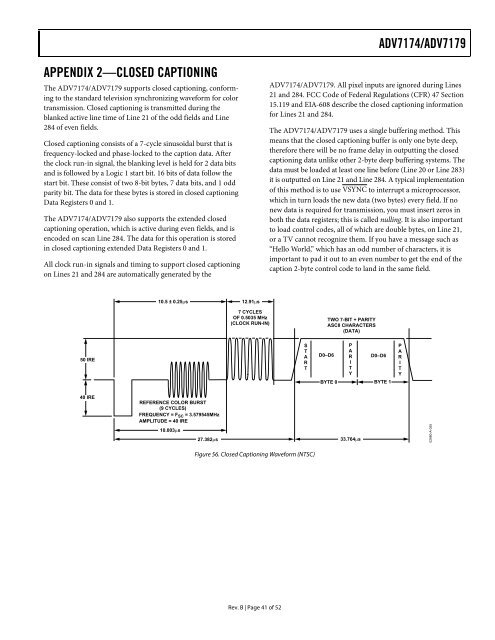ADV7174/ADV7179 Chip Scale PAL/NTSC Video ... - Analog Devices
ADV7174/ADV7179 Chip Scale PAL/NTSC Video ... - Analog Devices
ADV7174/ADV7179 Chip Scale PAL/NTSC Video ... - Analog Devices
Create successful ePaper yourself
Turn your PDF publications into a flip-book with our unique Google optimized e-Paper software.
APPENDIX 2—CLOSED CAPTIONING<br />
The <strong>ADV7174</strong>/<strong>ADV7179</strong> supports closed captioning, conforming<br />
to the standard television synchronizing waveform for color<br />
transmission. Closed captioning is transmitted during the<br />
blanked active line time of Line 21 of the odd fields and Line<br />
284 of even fields.<br />
Closed captioning consists of a 7-cycle sinusoidal burst that is<br />
frequency-locked and phase-locked to the caption data. After<br />
the clock run-in signal, the blanking level is held for 2 data bits<br />
and is followed by a Logic 1 start bit. 16 bits of data follow the<br />
start bit. These consist of two 8-bit bytes, 7 data bits, and 1 odd<br />
parity bit. The data for these bytes is stored in closed captioning<br />
Data Registers 0 and 1.<br />
The <strong>ADV7174</strong>/<strong>ADV7179</strong> also supports the extended closed<br />
captioning operation, which is active during even fields, and is<br />
encoded on scan Line 284. The data for this operation is stored<br />
in closed captioning extended Data Registers 0 and 1.<br />
All clock run-in signals and timing to support closed captioning<br />
on Lines 21 and 284 are automatically generated by the<br />
50 IRE<br />
40 IRE<br />
10.5 ± 0.25μs<br />
REFERENCE COLOR BURST<br />
(9 CYCLES)<br />
FREQUENCY = FSC = 3.579545MHz<br />
AMPLITUDE = 40 IRE<br />
10.003μs<br />
27.382μs<br />
12.91μs<br />
7 CYCLES<br />
OF 0.5035 MHz<br />
(CLOCK RUN-IN)<br />
Rev. B | Page 41 of 52<br />
<strong>ADV7174</strong>/<strong>ADV7179</strong><br />
<strong>ADV7174</strong>/<strong>ADV7179</strong>. All pixel inputs are ignored during Lines<br />
21 and 284. FCC Code of Federal Regulations (CFR) 47 Section<br />
15.119 and EIA-608 describe the closed captioning information<br />
for Lines 21 and 284.<br />
The <strong>ADV7174</strong>/<strong>ADV7179</strong> uses a single buffering method. This<br />
means that the closed captioning buffer is only one byte deep,<br />
therefore there will be no frame delay in outputting the closed<br />
captioning data unlike other 2-byte deep buffering systems. The<br />
data must be loaded at least one line before (Line 20 or Line 283)<br />
it is outputted on Line 21 and Line 284. A typical implementation<br />
of this method is to use VSYNC to interrupt a microprocessor,<br />
which in turn loads the new data (two bytes) every field. If no<br />
new data is required for transmission, you must insert zeros in<br />
both the data registers; this is called nulling. It is also important<br />
to load control codes, all of which are double bytes, on Line 21,<br />
or a TV cannot recognize them. If you have a message such as<br />
“Hello World,” which has an odd number of characters, it is<br />
important to pad it out to an even number to get the end of the<br />
caption 2-byte control code to land in the same field.<br />
S<br />
T<br />
A<br />
R<br />
T<br />
Figure 56. Closed Captioning Waveform (<strong>NTSC</strong>)<br />
TWO 7-BIT + PARITY<br />
ASCII CHARACTERS<br />
(DATA)<br />
P<br />
A<br />
D0–D6 R<br />
I<br />
T<br />
Y<br />
D0–D6<br />
BYTE 0 BYTE 1<br />
33.764μs<br />
P<br />
A<br />
R<br />
I<br />
T<br />
Y<br />
02980-A-055

















